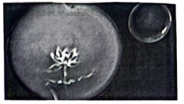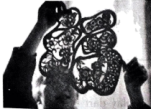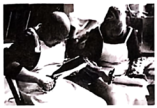1 . It’s common to see the coffee art, but have you seen the art in a cup of tea? This kind of tea art is called Dian Cha, a main tea drinking method in the Song Dynasty. The process of making it is not easy but people really enjoy Dian Cha especially because of the nice patterns on the surface of the tea.
The tea art begins with adding hot water over the fine powdered (粉末的) tea. This action creates a paste (糊状物) on the tea. Then add more water while whisking (搅动) it by hand with a bamboo whisk. It usually requires whisking about 200 times before the thick foam (泡沫) appears. Then, one can begin drawing. But drawing on the tea foam is not the same thing as drawing on the paper. One may use the hard teaspoon against the soft foam, which requires great attention. Unlike normal spoons, the teaspoon used in Dian Cha is quite thin and has a pointed end to help to draw, just like a pen.
In the Song Dynasty, many famous people regarded Dian Cha as an important free-time activity. Emperor Song Huizong even wrote a book called Treatise on Tea which included some details of tea-whisking. According to the book, good tea should be white and fine. The better the tea was, the whiter it should be, and the longer the foam should last.
In 2019, Dian Cha was listed as a cultural heritage (遗产) in Zhenjiang, China. A growing number of people now want to learn and spread this traditional skill. Han Zheming, a designer from Shanghai, has created nearly 200 images on the tea and put the process of Dian Cha online. “I want more people to understand and appreciate the beauty of Dian Cha.” Han says.

| A.Its long history. | B.Its patterns on the tea. |
| C.Its special taste. | D.Its tea-making process. |
A. | B. | C. | D.  |
| A.Better tea has much less foam. |
| B.Han Zheming tries to spread this tea art. |
| C.It was chosen as a cultural heritage in Shanghai. |
| D.Many famous people wrote Treatise on Tea together. |
| A.art and culture | B.sports and health | C.life and history | D.nature and travel |

The art of Chinese paper cutting, or jianzhi, has been around for thousands of years. The art form dates back to the Han Dynasty. During that time, paper was very expensive. It was mainly used for writing and making important documents (文件). During the Tang Dynasty, Chinese people started using paper for artistic expression. Since then, paper cutting has become popular.
Making a paper cutting takes three steps. First, the artist folds the paper into a proper shape. Then, the artist chooses a picture and draws it on the paper. As the last step, the artist carefully cuts out the picture with scissors or knives. The finished paper cuttings will be put on doors or windows. Common themes include animals, plants and traditional Chinese symbols. Paper cuttings with the Chinese characters fu, shou and xi are often seen as well. They are believed to bring good luck.
Chinese paper cutting is more than a traditional art form. It is also a symbol of Chinese culture. In recent years, it has been enjoyed by people all over the world. Many people try their best to protect this traditional art. They want to make sure that it will be passed down to more people.
Chinese paper cutting has a long history that goes back to the Han Dynasty. And it has been |
Kite flying is popular in China. Kites have become popular for use by everyone for pleasure. They are made of silk and bamboo. They are designed (设计) to act
It is said that kites
Chinese kites play
4 . China is an ancient nation. It has a long
My grandmother is over 90 years old. But she is very healthy. She is also good
Now, I also learn to make paper-cuttings. I hope that I can pass on the traditional art
| A.story | B.experience | C.history |
| A.created | B.invented | C.searched |
| A.your | B.our | C.their |
| A.for | B.to | C.at |
| A.since | B.if | C.until |
| A.widely | B.clearly | C.exactly |
| A.folk | B.white | C.local |
| A.strange | B.lively | C.brave |
| A.choose | B.improve | C.complete |
| A.form | B.message | C.festival |
however factory pair make be known she popular until for |

What kind of shoes do you wear most? Perhaps leather (皮制的) shoes or sports shoes. But in ancient China, many people
Tangchang, a town in Sichuan province with 700 years of shoemaking history, is
Over the time, sports shoes began to become more
Students at our school show their favorite art forms in handmade papers. Let’s see some of them.
Poems of Song Dynasty are very famous. Many great poets lived at that time, such as Su Shi and Li Qingzhao. We can read different topics like love and homesickness in those poems. That’s why I love it. Zhang Yibai |
|
I love Chinese oil-paper umbrellas not because they can protect people from rain or sunlight, but because they show poetic beauty. Zhou Yirui |
|
I like Dian Cha, a tea art from Song Dynasty. People “draw” beautiful pictures on the tea. I like it because it mixes tradition and fun together, which is very creative. Shen Bingying |
|
1. Who loves poems of Song Dynasty?
2. Why does Zhou Yirui love Chinese oil-paper umbrellas?
Because Chinese oil-paper umbrellas can
3. Which word means “诗歌的” in the passage?
It’s “
4. How many students share their favorite art forms in the passage?
5. Besides these art forms above, what’s your favorite Chinese art form?
My favorite Chinese art form is
7 . Pyrography (烫画) is a kind of art form in China. It is done by using a hot metal (金属) tool and burning wood or other surfaces (表面). Zhang Donghai, a 63-year-old man from Jinzhong, Shanxi Province, has been practising pyrography for more than 40 years.
Zhang began to learn pyrography when he was 20 years old. He learned it all by himself. After 20 years into it, Zhang started to make pyrographs on Xuan paper. He said that it is very difficult to master the skills for making pyrographs on Xuan paper. “I must carefully control the temperature of the electric soldering iron (电烙铁) and the speed of touching down the soldering iron onto the paper so as to avoid leaving holes in the paper.”
Zhang said. “Making pyrographs on Xuan paper requires lots of time and great patience.” Many people want to learn pyrography from Zhang, and Zhang is happy to train future inheritors (继承人) of the ancient art. “I prefer to train adults because electric soldering irons are dangerous to children.”
Zhang has created innovative (创新的) pyrographs by connecting the art form with the skills of traditional Chinese bird-and-flower paintings. Pyrography is a kind of valuable traditional cultural skill. I will continue to look for new innovations to make more pyrographs and do my best to pass on the art form to the young,” Zhang said.
1. What can we know from Paragraph 1?| A.What pyrography is. | B.The start of pyrography. |
| C.Zhang’s art collection. | D.Who taught Zhang pyrography. |
| A.learn traditional Chinese painting | B.make pyrographs on Xuan paper |
| C.train inheritors of pyrography | D.create pyrographs himself |
| A.finish sth. slowly | B.use sth. carelessly |
| C.learn sth. completely | D.make sth. quickly |
| A.Using colourful paper. | B.Making pyrographs on flowers. |
| C.Creating pyrographs of animals. | D.Using traditional Chinese painting skills. |
| A.An artist of pyrography | B.A foreign art form |
| C.The return of pyrography art | D.The creators of pyrography |
8 . 假设你的学校要举办以“Traditional Skills Around Us”为主题的活动,目前正在征集相关稿件,请你根据以下表格中的提示内容,以“A Person with a Traditional Skill”为题,用英语写一篇短文投稿,写出你眼中一位身怀传统技艺的人物。
Name | Li Qiyi (65 years old) |
Appearance | average height and a little thin, short hair and wearing glasses |
Specialty (特长) | good at paper-cutting; learned paper-cutting when he was 4 years old; skillful (熟练的), cut paper into different kinds of shapes; … |
Your opinion (观点) | … |
1.可参考表格提示内容,亦可适当发挥;
2.语句通顺,意思连贯,书写工整;
3.文中不得出现任何真实信息(姓名、校名和地名等);
4.词数:不少于60词。(开头已给出,但不计入总词数)
A Person with a Traditional Skill
Li Qiyi is a 65-year-old man.____________________________________________________________________________________________________________________________________________________________________________________________________________________________________________________________________________________________________________________________________________________________________________________________________________________________________________________________________________________________________________________________________________________________________________________________________________________________________________________________________________________________________________________________________________________________
9 . For the Spring Festival holiday, Wu Shaoyu managed to sell 230,000 yuan of handmade sugar on-line.
Wu grew up in Xuelan, a small village in Hainan Province. Most villagers there made a living by growing sugarcanes (甘蔗). “Every family knew how to make sugar by hand. They left some sugar at home for their children.
Hearing her father’s words, she decided to help pass on (传承) the old skills. “If we lose our tradition, we will lose our ground,” she said.
In 2013, Wu gave up her job in Shanghai and returned to Xuelan. She wanted to help protect and pass on the craft (手艺).
To make more people know about her sugar, Wu decided to use short videos.
As Wu’s business becomes successful,
“This is a dream that has come true,” she said. “
| A.However, few people are interested in the traditional sugar-making skills |
| B.sugar-making has been around in China for about 1,500 years |
| C.I am glad that the traditional sugar-making craft is catching people’s eyes |
| D.she is leading over 370 local families towards prosperity (繁荣) |
| E.Each different part of China has its own special kind of sugar |
| F.And they sold the rest at the local market to make money |
| G.She started uploading videos on the Internet in April 2020 |
10 . The Chinese are working hard to achieve their China Dream. And now the model worker spirit and craftsman (工匠) spirit are very popular. Here is a story of a great craftsman.
Born in 1949, Pan Qihui was once a PE teacher. He was interested in writing with brushes and painting as a child. His hobbies had nothing to do with his job, but he never gave them up. He also had interest in collecting stamps and ancient coins. However, since he saw the micro-carving (微雕) artworks at an exhibition in the 1980s, he decided to study micro-carving.
In 1986, Pan wrote 100 letters to his 100 pen friends who also enjoyed collecting stamps and ancient coins to tell them he had decided to spend ten years studying micro-carving and promised to send each of them a micro-carving work. Then, he practiced every night after work. Through hard work, he only spent five years achieving his dream.
Pan practices much and trains hard. He has set a goal for himself that he will create one amazing work every year. To make sure his hands remain stable (沉稳的), Pan has given up smoking and been living a healthy life. Pan says he loves micro-carving and will never give it up.
根据上面短文的内容回答问题 (每小题答案不超过6个单词)。1. When was Pan Qihui born?
2. How long did it take Pan to learn micro-carving well?
3. Why are the Chinese working hard?
4. What did Pan give up to make his hands remain stable?
5. What do you think of Pan Qihui?






